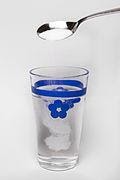Solution Properties Concentration - Characteristics, Types, FAQs
What is a solution in science and give solution examples?
A solution is a homogenous mixture of two or more substances with particle sizes ranging from 0.1nm to 1 nm. The term "homogeneous" refers to a mixture's components forming a single phase. All the components of a solution appear as a single phase. There is particle homogeneity or a uniform distribution of particles.

A liquid solution is made up of a solid, liquid, or gas that has been dissolved in a liquid solvent. Similarly, a solid solution is made up of a solid, liquid, or gas dissolved in a solid solvent.
Also read -
Characteristics of a solution properties concentration
What is a solute?
Solution definition chemistry and Solution meaning: A solute is a solid, liquid, or gas which is dissolved to make solution. A solute is dissolved in a solvent to make a solution
What is a solvent?
A solvent is the component of a solution in which a solute is dissolved. It is more abundant in solution chemistry than the solute.
What are the properties of the solution?
The following are some of the properties of solutions:
It is a completely homogeneous mixture.
Its particles are too small, with a diameter of less than 1 nm.
The particles cannot be seen with the naked eye.
A beam of light moving through particles does not scatter, therefore the path of the light is not visible.
Filtration cannot separate the constituents of a combination.
Different types of solution properties concentration
1. Based on solute and solvent
The most common type of solution is a liquid, such as sugar in water, but there are also solutions that are gases or solids. During the formation of a solution, any state of matter (solid, liquid, or gas) can act as both a solute and a solvent. As a result, we may divide solutions into nine categories based on the physical states of the solute and solvent.
Sl. No | Types of solution | Examples | Solute | Solvent |
1 | Solid in solid solution example | Alloys like bonze and brass | Solid | Solid |
2 | Solid in liquid solution example | The solution of salt and sugar in water. | Solid | Liquid |
3 | Solid in gas solution example | Sublimation of iodine, camphor in air | Solid | Gas |
4 | Liquid in solid solution example | Amalgams (mercury in silver ) | Liquid | Solid |
5 | Liquid in liquid solution example | Alcohol in water, benzene in toluene | Liquid | Liquid |
6 | Liquid in gas solution example | Aerosol | Liquid | Gas |
7 | Gas in solid solution example | Hydrogen absorbed in palladium | Gas | Solid |
8 | Gas in liquid solution example | Aerated drinks | Gas | Liquid |
9 | Gas in gas solution example | Mixture of gases | Gas | Gas |
Related Topics Link, |
Based on quantity of solute in solution
- Unsaturated Solution - An unsaturated solution is one in which we can add more solute at given temperature.
- Supersaturated Solution - A supersaturated solution is a saturated solution to which more solute is added by increasing the temperature or pressure. Generally, crystals begin to form in these solutions.
Saturated Solution - A saturated solution is one in which no more solute can be dissolved in the solvent at given temperature.
The Concentration of a solution
Concentration meaning in chemistry: The concentration of a solution refers to the amount of solute in a specific solution. In solutions, the proportions of solute and solvent are not equal. A solution can be one of the following, depending on the percentage of solute:
Diluted
Concentrated
Saturated
Concentration of solution = Amount of solute / Amount of solution
A solution's concentration can be expressed both quantitatively and qualitatively. It can be described qualitatively as a dilute solution for or a concentrated solution. It can be stated quantitatively in terms of mass percentage, volume percentage, parts per million, and so on.
Mass Percentage (w/w) = Mass of solute / Total mass of solution × 100
Volume Percentage (v/v) = Volume of solute / Total volume of solution × 100
Mass by volume Percentage (w/v) = Mass of solute(g) / Volume of solution(ml) × 100
Parts per million (ppm) = Number of parts of the component / Total number of parts of all the components of the solution × 106
Mole fraction of solute = Moles of solute / Moles of solute + moles of solvent
Molarity = Moles of solute / Volume of solvent in litre
Molality =Mass of solute / Mass of solvent in kg
Also Read:
Solubility
A solubility of a substance refers to the greatest amount of solvent that may be dissolved in a given amount of solvent at a given temperature.
The Solubility of a Substance is affected by the Following Factors –
Nature of the Solute
The nature of the solvent
Temperature
Pressure
What is a mixture?
Mixtures are compounds made up of two or more different kinds of materials. Mixtures include things like air, earth, blood, and so on. Mixtures are classified as homogeneous or heterogeneous based on the nature of the components and their distribution. A homogeneous mixture is one in which the constituents are evenly distributed. The mixture is called a heterogeneous mixture if the distribution is not uniform. A solution is a mixture of two or more components that is homogeneous.
Also check-
- NCERT Exemplar Class 11th Chemistry Solutions
- NCERT Exemplar Class 12th Chemistry Solutions
- NCERT Exemplar Solutions for All Subjects
NCERT Chemistry Notes: